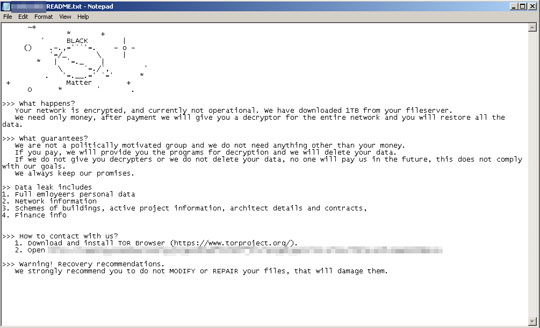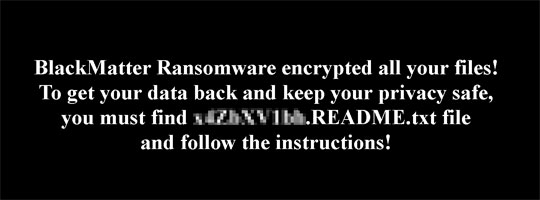Ransom.Win32.BLACKMATTER.THGOCBA
Trojan-Ransom.BlackMatter (IKARUS)
Windows


Threat Type: Ransomware
Destructiveness: No
Encrypted: Yes
In the wild: Yes
OVERVIEW
This Ransomware arrives on a system as a file dropped by other malware or as a file downloaded unknowingly by users when visiting malicious sites.
It drops files as ransom note. It avoids encrypting files with the following file extensions.
TECHNICAL DETAILS
Arrival Details
This Ransomware arrives on a system as a file dropped by other malware or as a file downloaded unknowingly by users when visiting malicious sites.
Installation
This Ransomware drops the following files:
- used as wallpaper:
- %ProgramData%\{appended ransomware extension}.bmp
(Note: %ProgramData% is a version of the Program Files folder where any user on a multi-user computer can make changes to programs. This contains application data for all users. This is usually C:\ProgramData on Windows Vista, 7, 8, 8.1, 2008(64-bit), 2012(64-bit) and 10(64-bit), or C:\Documents and Settings\All Users on Windows Server 2003(32-bit), 2000(32-bit) and XP.)
It adds the following processes:
- if -safe is used:
- bcdedit /set {current} safeboot network
It adds the following mutexes to ensure that only one of its copies runs at any one time:
- Global\{Generated hash based on GUID}
Autostart Technique
This Ransomware adds the following registry entries to enable its automatic execution at every system startup:
HKEY_LOCAL_MACHINE\SOFTWARE\Microsoft\
Windows\CurrentVersion\RunOnce
*{random} = {malware path}\{malware name}
Other System Modifications
This Ransomware adds the following registry entries:
HKEY_LOCAL_MACHINE\SOFTWARE\{appended ransomware extension}
hScreen = {screen height}
HKEY_LOCAL_MACHINE\SOFTWARE\{appended ransomware extension}
wScreen = {screen width}
HKEY_LOCAL_MACHINE\SOFTWARE\Microsoft\
Windows NT\CurrentVersion\Winlogon
AutoAdminLogon = 1
HKEY_LOCAL_MACHINE\SOFTWARE\Microsoft\
Windows NT\CurrentVersion\Winlogon
DefaultUserName = Administrator
HKEY_LOCAL_MACHINE\SOFTWARE\Microsoft\
Windows NT\CurrentVersion\Winlogon
DefaultDomainName = {Computer name}
HKEY_LOCAL_MACHINE\SOFTWARE\Microsoft\
Windows NT\CurrentVersion\Winlogon
DefaultPassword = {random string}
It changes the desktop wallpaper by modifying the following registry entries:
HKEY_CURRENT_USER\Control Panel\Desktop
WallPaper = %ProgramData%\{appended ransomware extension}.bmp
HKEY_CURRENT_USER\Control Panel\Desktop
WallpaperStyle = 10
It sets the system's desktop wallpaper to the following image:
Process Termination
This Ransomware terminates the following services if found on the affected system:
- mepocs
- memtas
- veeam
- svc$
- backup
- sql
- vss
It terminates the following processes if found running in the affected system's memory:
- encsvc
- thebat
- mydesktopqos
- xfssvccon
- firefox
- infopath
- winword
- steam
- synctime
- notepad
- ocomm
- onenote
- mspub
- thunderbird
- agntsvc
- sql
- excel
- powerpnt
- outlook
- wordpad
- dbeng50
- isqlplussvc
- sqbcoreservice
- oracle
- ocautoupds
- dbsnmp
- msaccess
- tbirdconfig
- ocssd
- mydesktopservice
- visio
Information Theft
This Ransomware gathers the following data:
- Machine GUID
- Computer name
- Hostname
- Username
- Domain
- OS Architecture
- Language
- Disk information (free size, disk size)
- Total number of files
- Total number of encrypted files
Stolen Information
This Ransomware sends the gathered information via HTTP POST to the following URL:
- http://{BLOCKED}hacks.com/{encrypted gathered information}
- http://{BLOCKED}den.com/{encrypted gathered information}
Other Details
This Ransomware adds the following registry keys:
HKEY_LOCAL_MACHINE\SOFTWARE\{appended ransomware extension} → deleted after execution
It does the following:
- If not executed with admin rights, it will relaunch itself as admin
- It encrypts fixed, removable and network drives
- It deletes files in recycle bin folder for removable and fixed drives
- It uses WQL to delete shadow copies
- It attempts logging in to infected machine using the following credentials:
- Username: {BLOCKED}er@{BLOCKED}p.com
Password: {BLOCKED}er - Username: {BLOCKED}h@{BLOCKED}p.com
Password: {BLOCKED}19 - Username: {BLOCKED}r@{BLOCKED}p.com
Password: {BLOCKED}**
- Username: {BLOCKED}er@{BLOCKED}p.com
It accepts the following parameters:
- -path {target path} → specifies directory to be encrypted
- -wall → changes wallpaper only
- -safe → executes ransomware routine on safe mode by:
- modifying Winlogon registry:
- to enable automatic logon
- to set default username, domain name, and password
- adding specific process to enable safeboot
- shutting system down after
- modifying Winlogon registry:
Ransomware Routine
This Ransomware avoids encrypting files with the following strings in their file name:
- ntuser.ini
- ntuser.dat.log
- autorun.inf
- thumbs.db
- desktop.ini
- boot.ini
- ntldr
- ntuser.dat
- iconcache.db
- bootsect.bak
- bootfont.bin
- {appended ransomware extension}.README.txt
It avoids encrypting files found in the following folders:
- $recycle.bin
- $windows.~bt
- $windows.~ws
- all users
- appdata
- application data
- boot
- config.msi
- default
- intel
- mozilla
- msocache
- perflogs
- program files
- program files (x86)
- programdata
- public
- system volume information
- tor browser
- windows
- windows.old
It appends the following extension to the file name of the encrypted files:
- {string generated from Machine GUID}
It drops the following file(s) as ransom note:
- {appended ransomware extension}.README.txt

It avoids encrypting files with the following file extensions:
- 386
- adv
- ani
- bat
- bin
- cab
- cmd
- com
- cpl
- cur
- deskthemepack
- diagcab
- diagcfg
- diagpkg
- dll
- drv
- exe
- hlp
- hta
- icl
- icns
- ico
- ics
- idx
- key
- ldf
- lnk
- lock
- mod
- mpa
- msc
- msi
- msp
- msstyles
- msu
- nls
- nomedia
- ocx
- pdb
- prf
- ps1
- rom
- rtp
- scr
- shs
- spl
- sys
- theme
- themepack
- wpx
SOLUTION
Step 1
Trend Micro Predictive Machine Learning detects and blocks malware at the first sign of its existence, before it executes on your system. When enabled, your Trend Micro product detects this malware under the following machine learning name:
- Troj.Win32.TRX.XXPE50FFF046
Step 2
Before doing any scans, Windows 7, Windows 8, Windows 8.1, and Windows 10 users must disable System Restore to allow full scanning of their computers.
Step 3
Note that not all files, folders, and registry keys and entries are installed on your computer during this malware's/spyware's/grayware's execution. This may be due to incomplete installation or other operating system conditions. If you do not find the same files/folders/registry information, please proceed to the next step.
Step 4
Restart in Safe Mode
Step 5
Delete this registry value
Important: Editing the Windows Registry incorrectly can lead to irreversible system malfunction. Please do this step only if you know how or you can ask assistance from your system administrator. Else, check this Microsoft article first before modifying your computer's registry.
- In HKEY_LOCAL_MACHINE\SOFTWARE\Microsoft\Windows NT\CurrentVersion\Winlogon
- AutoAdminLogon = 1
- AutoAdminLogon = 1
- In HKEY_LOCAL_MACHINE\SOFTWARE\Microsoft\Windows NT\CurrentVersion\Winlogon
- DefaultUserName = Administrator
- DefaultUserName = Administrator
- In HKEY_LOCAL_MACHINE\SOFTWARE\Microsoft\Windows NT\CurrentVersion\Winlogon
- DefaultDomainName = {Computer name}
- DefaultDomainName = {Computer name}
- In HKEY_LOCAL_MACHINE\SOFTWARE\Microsoft\Windows NT\CurrentVersion\Winlogon
- DefaultPassword = {random string}
- DefaultPassword = {random string}
- In HKEY_LOCAL_MACHINE\SOFTWARE\Microsoft\Windows\CurrentVersion\RunOnce
- *{random} = {malware path}\{malware name}
- *{random} = {malware path}\{malware name}
Step 6
Delete this registry key
Important: Editing the Windows Registry incorrectly can lead to irreversible system malfunction. Please do this step only if you know how or you can ask assistance from your system administrator. Else, check this Microsoft article first before modifying your computer's registry.
- In HKEY_LOCAL_MACHINE\SOFTWARE\{appended ransomware extension}
Step 7
Search and delete this file
- %ProgramData%\{extension}.bmp
- {appended ransomware extension}.README.txt
Step 8
Reset your Desktop properties
Step 9
Restart in normal mode and scan your computer with your Trend Micro product for files detected as Ransom.Win32.BLACKMATTER.THGOCBA. If the detected files have already been cleaned, deleted, or quarantined by your Trend Micro product, no further step is required. You may opt to simply delete the quarantined files. Please check this Knowledge Base page for more information.
Step 10
Restore encrypted files from backup.
Did this description help? Tell us how we did.




